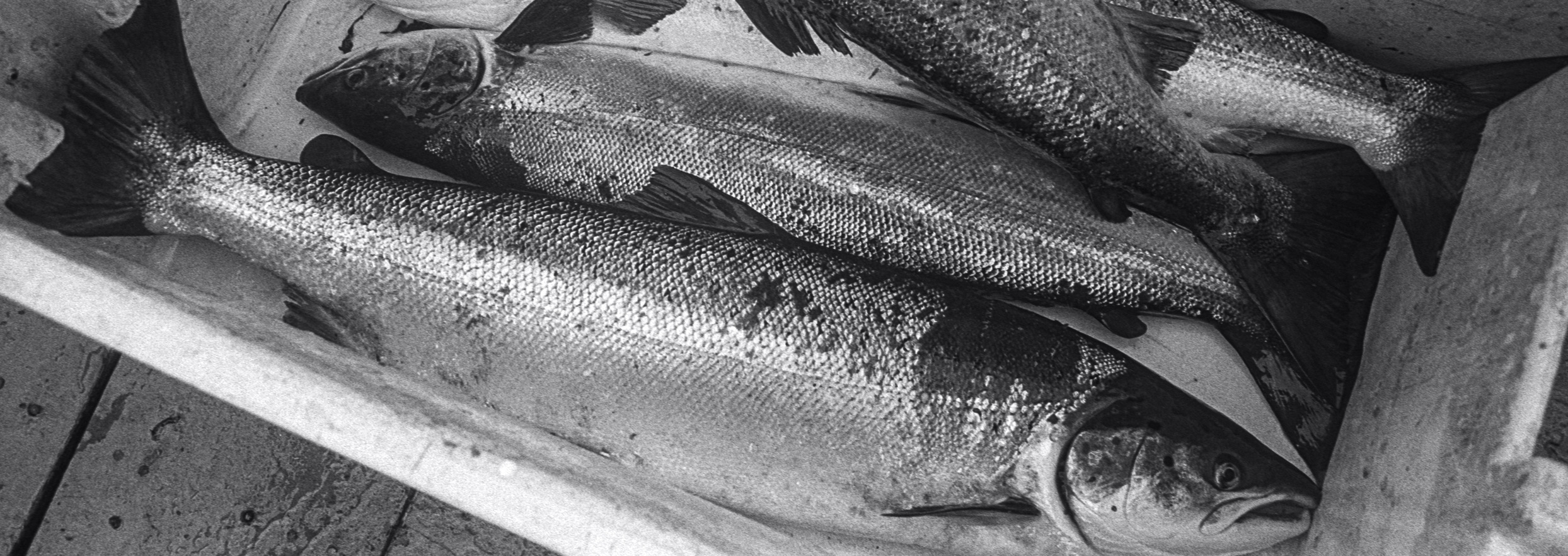The Middle of the Day

© Don McAllester
Photo 207
Passing Ardtoe Island at Kilmory Point looking to see how the nets were lying. If the tide was rising, on the flood , the boat had to start fishing the net on one side. If the tide was falling, on the ebb, the boat would have to start fishing on the other side of the net. You could tell which way the tide was going by how the leader was lying: bowed to the south east and it was a flood tide, to the north west an ebb tide

© Don McAllester
Photo 208
Approaching the net at Kilmory Point
The headpole is standing vertically which shows the net is sitting well in the water. A good thing

© Don McAllester
Photo 209
The boat is now lying alongside the net. Paul is holding the net bridle; Rhoddy is just getting hold of the head pole
You can see this whole process in “Scottish Wild Salmon Company” footage in Videos

© Don McAllester
Photo 210
Rhoddy is now untying “springing” the headpole. Paul is holding the boat steady on the bridle. The headpole is one of the three poles that hold the net open and upright in the water

© Don McAllester
Photo 211
The headpole is now untied and falling out of the way. The crew are pulling the boat forward so that it is alongside the “fish court”: the chamber of the head net where hopefully there are fish

© Don McAllester
Photo 212
The boat is now as far forward as it needs to be. The headpole is lying out of the way. The crew are hauling on the “pull ropes” to bring up the floor part of the net

© Don McAllester
Photo 213
The boat has now been pulled across the net with the crew leaning over the side to hold the floor of the net to the surface thus forcing the fish into the bag created by the side wall of the net

© Don McAllester
Photo 214
The bag, with a fish in it, is being lifted up over the side and into the boat

© Don McAllester
Photo 214.1
The crew have now lifted the “bag” over the side and into the boat so that the fish can be emptied out of the net. The fish are very much alive.
There is good video of this in the CNN film on Videos

© Don McAllester
Photo 215
The crew are trying to get hold of a fish that has managed to get to the other side of the boat having been tipped out of the bag

© Don McAllester
Photo 216
Rhoddy has caught the fish and is dispatching it with what was called at Fascadale a “paddy” in other places a “priest” It was a ladder rung. Rhoddy was often heard to say “Morning Vicar” as he did this

© Don McAllester
Photo 217
The fish is finally dealt with

© Don McAllester
Photo 218
Not all the fish were swimming in the fish court when the net was fished. Here Rhoddy is trying to get at a fish caught by the gills, hung, in the wing of the net.

© Don McAllester
Photo 220
Working to get the “hanger” out. Paul is reaching back to pass Rhoddy a “paddy”

© Don McAllester
Photo 221
Paul now has the fish by the tail as Rhoddy deals with it, “paddy” in hand

© Don McAllester
Photo 222
Paul putting a freshly caught salmon into a fish box. Rhoddy is looking into the net, checking for damage and making sure there are no fish left in any corner. Salmon are very beautiful fish and the crew did their best to keep the fish in their best condition. Buckets of water were poured over dry decks before the catch were brought aboard to prevent the loss of any scales and thus some of their value. The fish in the photo has lost some of the scales around its “shoulders” probably by being caught in the mesh of the net. Most of the fish brought aboard were still swimming freely in the “fish court” head of the net when net was fished.
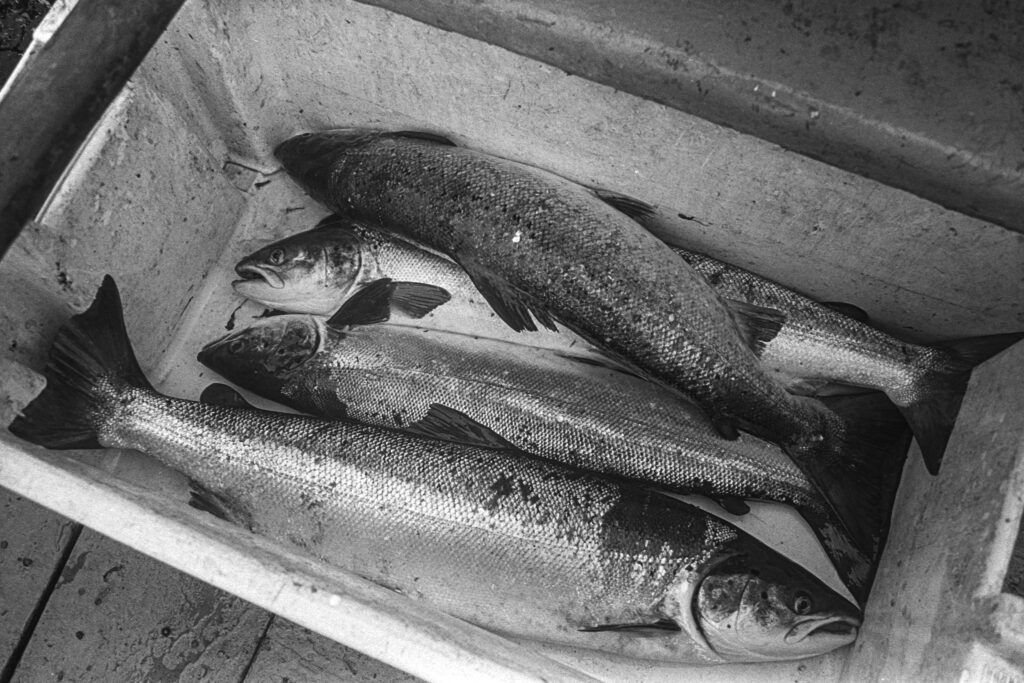
© Don McAllester
Photo 223
A box with four freshly caught
fish . The Glasgow fish market, where these fish were sold, differentiated between “salmon” and “grilse” According to the market a salmon was a salmon of more than 8lbs, a grilse a salmon of less than 8lbs. In scientific terms a grilse is a salmon that has only spent one winter at sea, a salmon a fish that has spent more than one winter at sea. The market paid more per pound for salmon than they did for grilse The big fish in the box is definitely a salmon, the other three look to be grilse. Unfortunately the big fish in the box, the salmon, has lost some of its scales by it shoulders. A fish like this would get slightly less at the market than a perfect fish.
The fish had quite a journey to the market. After being rinsed, weighed and boxed at Fascadale these fish were carefully packed: The boxes were lined with wet newspaper to provide insulation then the fish placed belly up, covered in crushed ice and the lids nailed down. Fresh salmon was a luxury food. The fish went to market whole, ungutted. The salmon farming industry was in its infancy in Britain: for most people fresh salmon was a difficult to get treat, and smoked salmon maybe only at Christmas. Changed days.
The fish boxes, each at just over a hundred weight (50+kgs) were taken by car and trailer to the Tobermory ferry at Mingary Pier, Kilchoan. In 1975 the ferry the “Lochnell” was a passenger only service. Using the manual crane on the pier the boxes were lifted onto the “Lochnell “which then set off for Tobermory. From there onto a lorry and down to Craignure on Mull for the ferry to Oban then from there by road to the Glasgow fish market A fish taken out of the sea on Tuesday morning would be at the market on Wednesday morning.
The value of the catch was very much driven by the economic law of supply and demand. At the start and end of the season, when very few fish were being landed the price per pound was high, in the middle of the season, during the “grilse run” when more fish were reaching the market, the price went down. These were the days before fish farming. Salmon was a luxury seasonal food and it commanded a high price. At the start of the season a salmon, a more than 8 lbs fish could get as much as £3.00 a pound. In high season a grilse might only be getting £1.40 a pound. Interestingly at the start and end of the season the catch was mainly salmon but not many of them, the main part of the season the catch was largely grilse.
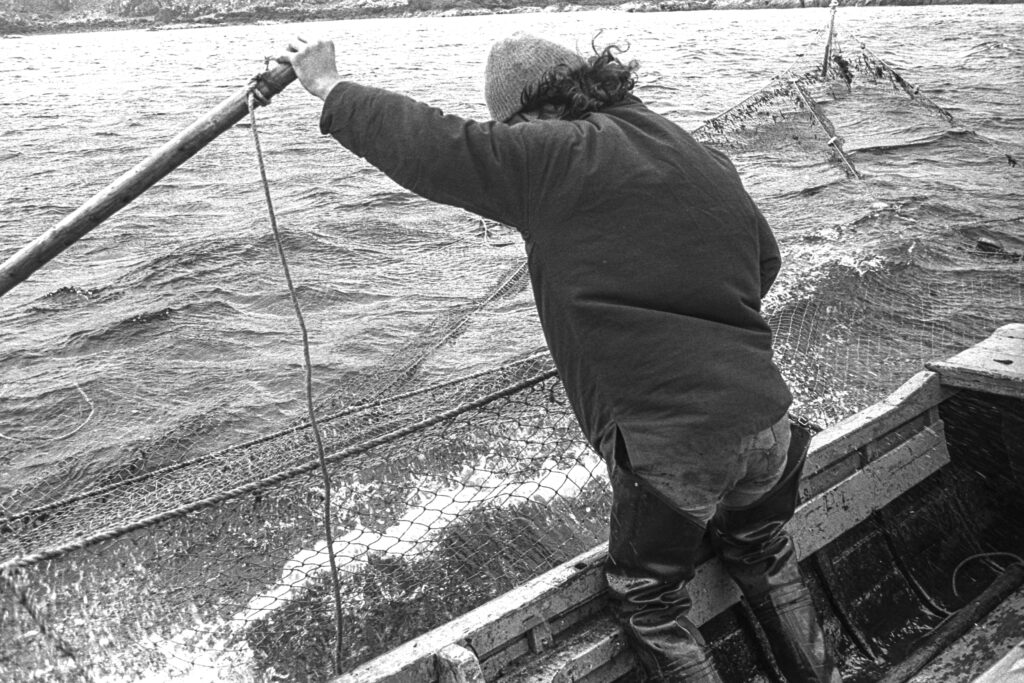
© Don McAllester
Photo 224
The boat is alongside the net, bow out. Paul is holding the “head pole” in one hand and the net in the other.
This photo clearly shows the height of the side of the boat in relation to the height of the man. This boat had a very low “freeboard” (height of the side of the boat above the water) To an extent this was an advantage as much of the work on the nets required the crew to be leaning over the side of the boat to reach the net in the water. On the other hand the low freeboard offered little protection from the splashes and spray of the sea and little protection to somebody who might fall overboard
Lifejackets were not worn on the Fascadale boats: indeed the cobles carried no life saving nor any safety equipment. The protective clothing issued to the crew, a pair of thigh boots and a frock oilskin (see photo SSS link)would have made staying afloat in the water very difficult.
The fisherman in this photo is wearing thigh boots.
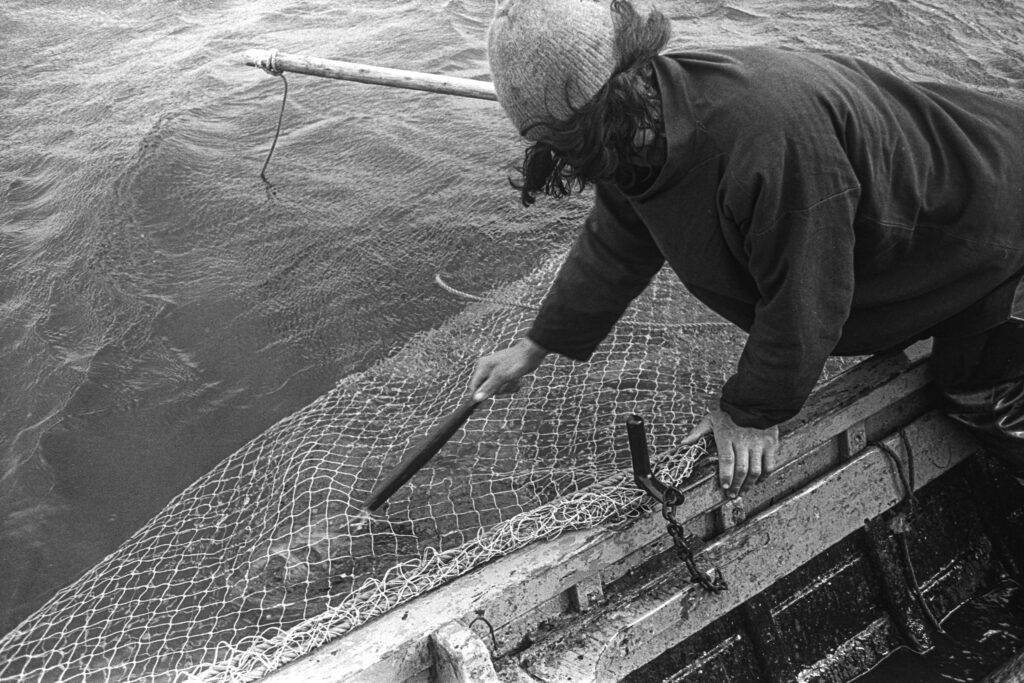
© Don McAllester
Photo 225
Jellyfish. These are the almost transparent type with the purple pattern on them. Harmless but heavy. The nets caught a lot more jellyfish than they did salmon. The quantity of jellyfish in the net was often a surprise and it was unknown what drove this variation: the tide, the wind, water temperature, a mystery. If the net was full of jellies the bag would be too heavy to be lifted into the boat to get at the fish. The jellies had to be got out by unlacing part of the side of the net then tipping the jellies out while making sure not to let a fish escape. Heavy tense work And then there were the red jellies, the stingers……
There is good video of the jellyfish problem in the “Scottish Wild Salmon Company” footage in Videos

© Don McAllester
Photo 226
Still trying to get the jellyfish out of the net
Paul “steering” and pushing jellyfish towards the fish door
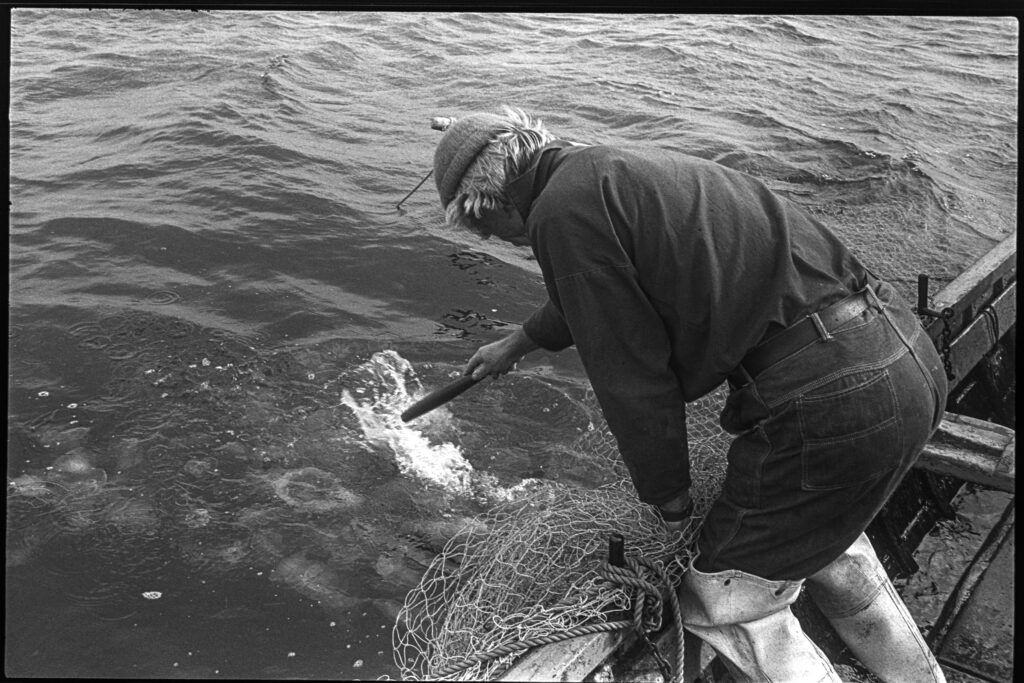
© Don McAllester
Photo 227
Jellyfish
Rhoddy is now at work clearing the net of jellyfish
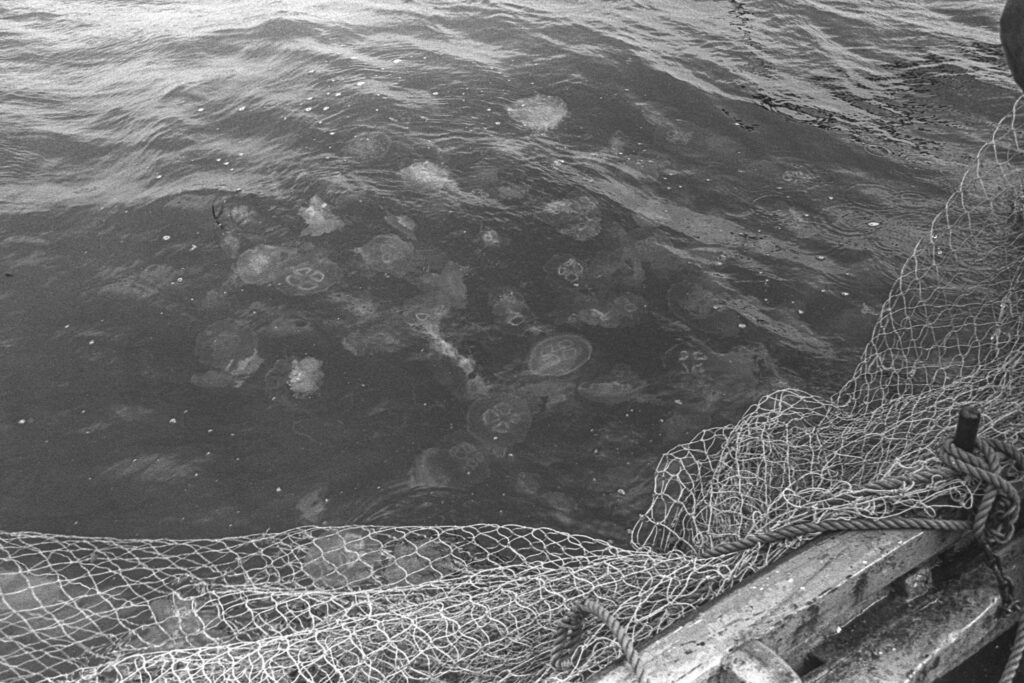
© Don McAllester
Photo 228
The jelly fish are now out of the net
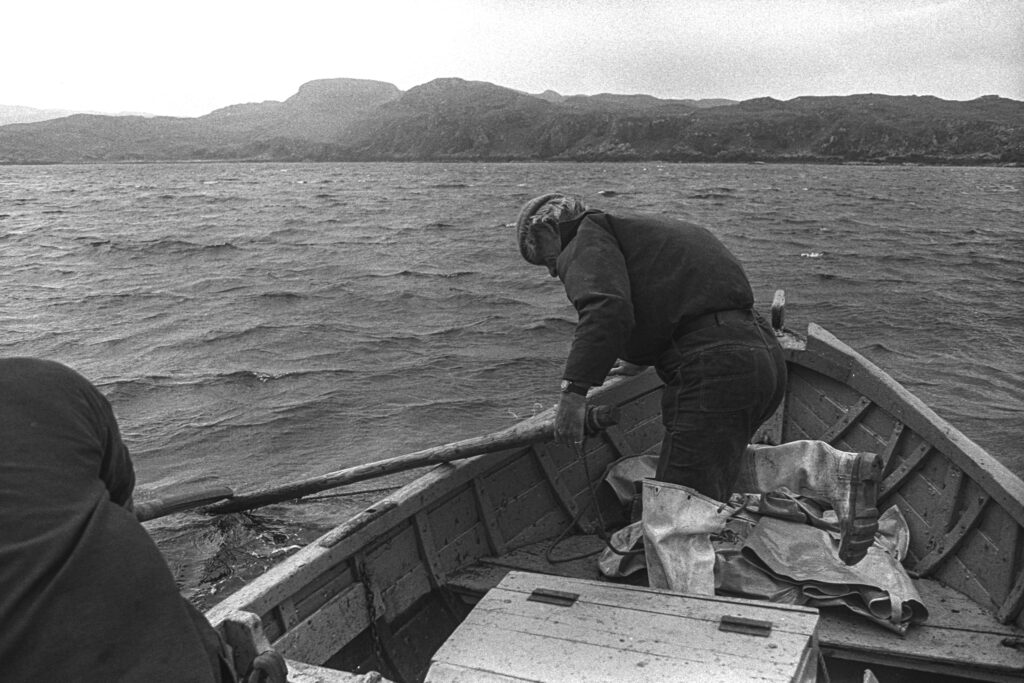
© Don McAllester
Photo 229
The crew are setting the net up to fish again. The headpole must be pulled back into position. Paul is pulling on the headpole with the boathook so that Rhoddy can catch the end of it
There is now quite strong breeze trying to push the boat away from the net
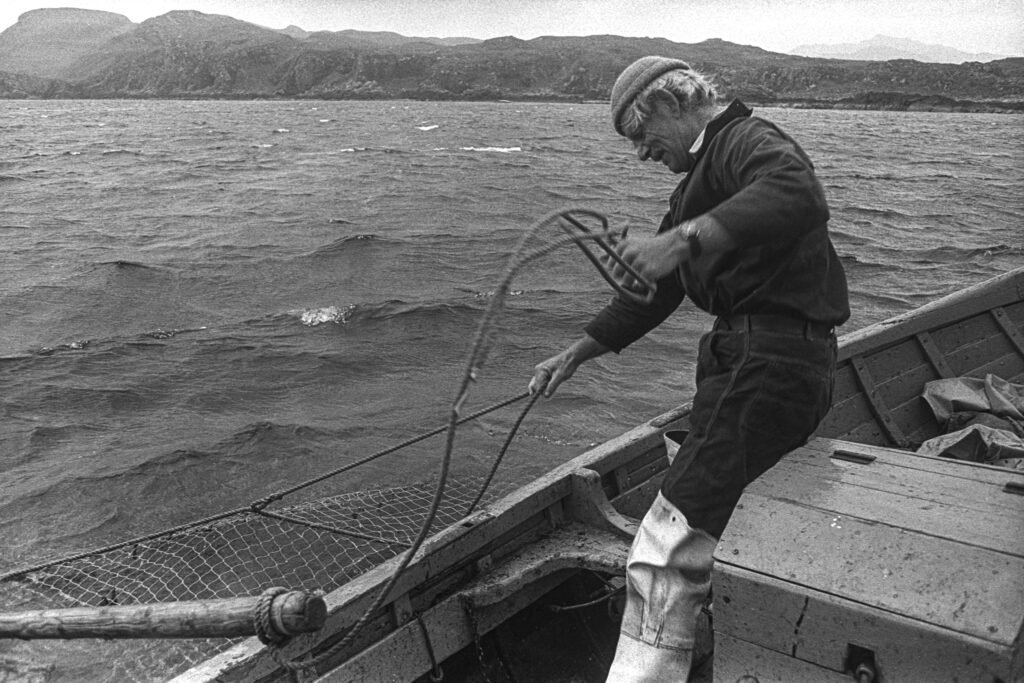
© Don McAllester
Photo 230
Rhoddy is holding onto a pull rope with his right hand to keep the boat in position whilst flicking the headpole rope to Paul with his left hand

© Don McAllester
Photo 231
Rhoddy is still holding onto the rope to keep the boat in position: Paul is holding the headpole and trying to pull the boat into position using the boathook
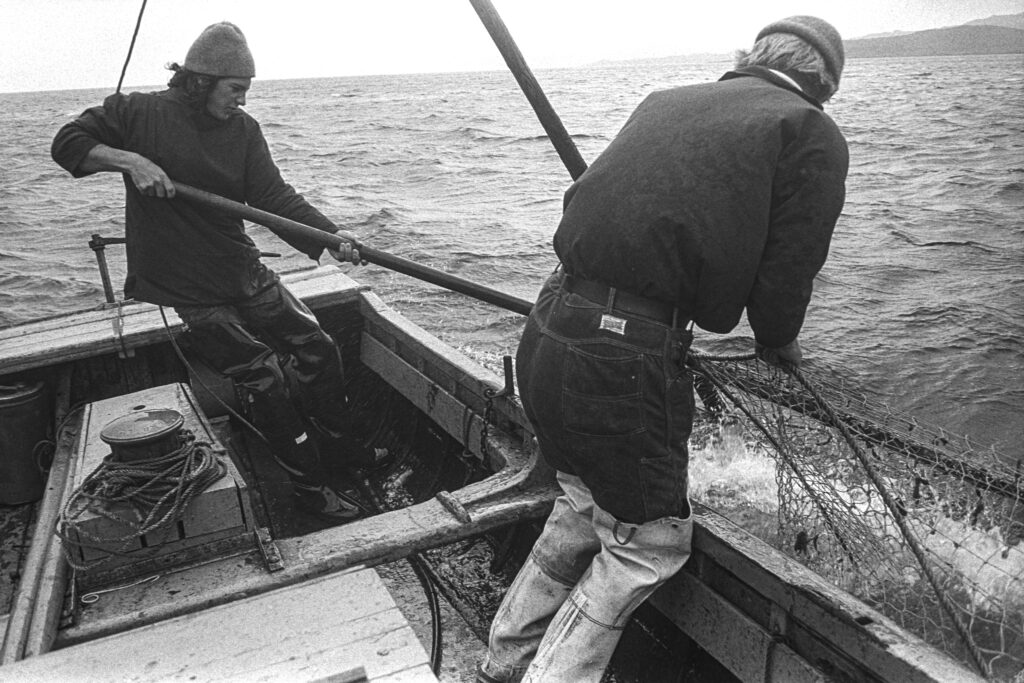
© Don McAllester
Photo 232
The headpole is now in the right place but the crew are working hard to keep the boat up to the net

© Don McAllester
Photo 233
Putting the “headpole” back in place
The boat is now almost secure so Rhoddy can start pushing down the headpole

© Don McAllester
Photo 234
On the way back to Fascadale with Ardtoe Island, Kilmory Point in the backgroun
Part Three: The End of the Day
